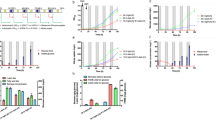Abstract
Chlorella is a promising alternative resource of lutein (xanthophyll) production as it can be cultivated heterotrophically in fermentors. In this paper, a kinetic model for lutein production by heterotrophic Chlorella pyrenoidosa was developed based on batch cultivations in 250-ml flasks and a 19-l fermentor. The model was validated by experimental data from two fed-batch cultivations performed in the same fermentor. The dynamic behavior of lutein production by C. pyrenoidosa with various concentrations of glucose and nitrogen was analyzed based on the kinetic model. Model-based analyses suggested that glucose concentrations between 5 and 24 g/l and nitrogen concentrations between 0.7 and 12 g/l during the cultivation were favorable for lutein production by heterotrophic C. pyrenoidosa. It also showed that fed-batch cultivations are more suitable for efficient production of lutein than batch ones. The results obtained in this study may contribute to commercial lutein production by heterotrophic Chlorella.




Similar content being viewed by others
References
Alcantara S, Sanchez S (1999) Influence of carbon and nitrogen sources on Flavobacterium growth and zeaxanthin biosynthesis. J Ind Microbiol Biotechnol 23:697–700
Brinda BR, Sarada R, Kamath BS, Ravishankar GA (2004) Accumulation of astaxanthin in flagellated cells of Haematococcus pluvialis—cultural and regulatory aspects. Curr Sci 87:1290–1295
Cardinault N, Gorrand JM, Tyssandier V, Grolier P, Rock E, Borel P (2003) Short-term supplementation with lutein affects biomarkers of lutein status similarly in young and elderly subjects. Exp Gerontol 38:573–582
Chen F, Zhang YM, Guo SY (1996) Growth and phycocyanin formation of Spirulina platensis in photoheterotrophic culture. Biotechnol Lett 18:603–608
Fabregas J, Dominguez A, Maseda A, Otero A (2003) Interactions between irradiance and nutrient availability during astaxanthin accumulation and degradation in Haematococcus pluvialis. Appl Microbiol Biotechnol 61:545–551
Garbayo I, Vilchez C, Nava-Saucedo JE, Barbotin JN (2003) Nitrogen, carbon and light-mediated regulation studies of carotenoid biosynthesis in immobilized mycelia of Gibberella fujikuroi. Enzyme Microb Technol 33:629–634
Kim HW, Chew BP, Wong TS, Park JS, Weng BB, Byrne KM, Hayek MG, Reinhart GA (2000) Dietary lutein stimulates immune response in the canine. Vet Immunol Immunopathol 74:315–327
Krinsky NI, Landrum JT, Bone RA (2003) Biological mechanisms of the protective role of lutein and zeaxanthin in the eye. Annu Rev Nutr 23:171–201
Landrum JT, Bone RA (2001) Lutein, zeaxanthin, and the macular pigment. Arch Biochem Biophys 385:28–40
Mares-Perlman JA, Millen AE, Ficek TL, Hankinson SE (2002) The body of evidence to support a protective role for lutein and zeaxanthin in delaying chronic disease. Overview. J Nutr 132:5185–5245
Miao XL, Wu QY (2004) High yield bio-oil production from fast pyrolysis by metabolic controlling of Chlorella protothecoides. J Biotechnol 110:85–93
Miller GL (1959) Use of dinitrosalicylic acid reagent for determination of reducing sugar. Anal Chem 31:426–429
Miller SR, Martin M, Touchton J, Castenholz RW (2002) Effects of nitrogen availability on pigmentation and carbon assimilation in the cyanobacterium Synechococcus sp. strain SH-94–5. Arch Microbiol 177:392–400
Olmedilla B, Granado F, Blanco I, Vaquero M (2003) Lutein, but not α-tocopherol, supplementation improves visual function in patients with age-related cataracts: a 2-y double-blind, placebo-controlled pilot study. Nutrition 19:21–24
Parajo JC, Santos V, Vazquez M (1998) Optimization of carotenoid production by Phaffia rhodozyma cells grown on xylose. Proc Biochem 33:181–187
Phadwal K, Singh PK (2003) Effect of nutrient depletion on beta-carotene and glycerol accumulation in two strains of Dunaliella sp. Bioresour Technol 90:55–58
SEPA (1998) Manual on water and waste water analysis. State Environmental Protection Administration, China, pp266–269
Shi XM, Chen F (1999) Production and rapid extraction of lutein and the other lipid-soluble pigments from Chlorella protothecoides grown under heterotrophic and mixotrophic conditions. Nahrung 43:109–113
Shi XM, Chen F, Yuan JP, Chen H (1997) Heterotrophic production of lutein by selected Chlorella strains. J Appl Phycol 9:445–450
Shi XM, Jiang Y, Chen F (2002) High-yield production of lutein by the green microalga Chlorella protothecoides in heterotrophic fed-batch culture. Biotechnol Proc 18: 723–727
Shi XM, Liu HJ, Zhang XW, Chen F (1999) Production of biomass and lutein by Chlorella protothecoides at various glucose concentrations in heterotrophic cultures. Proc Biochem 34:341–347
Shi XM, Zhang XW, Chen F (2000) Heterotrophic production of biomass and lutein by Chlorella protothecoides on various nitrogen sources. Enzyme Microb Technol 27:312–318
Somashekar D, Joseph R (2000) Inverse relationship between carotenoid and lipid formation in Rhodotorula gracilis according to the C/N ratio of the growth medium. World J Microbiol Biotechnol 16:491–493
Wu ZY, Shi XM (2007) Optimization for high-density cultivation of heterotrophic Chlorella based on a hybrid neural network model. Lett Appl Microbiol 44:13–18. DOI 10.1111/j.1472–765X.2006.02038.x
Yuan JP, Chen F, Liu X, Li XZ (2002) Carotenoid composition in the green microalga Chlorococcum. Food Chem 76:319–325
Zhang XW, Shi XM, Chen F (1999) A kinetic model for lutein production by the green microalga Chlorella protothecoides in heterotrophic culture. J Ind Microbiol Biotechnol 23:503–507
Acknowledgment
This research was supported by Ministry of Science and Technology of the People’s Republic of China (863 project No. 2006AA02Z226).
Author information
Authors and Affiliations
Corresponding author
Rights and permissions
About this article
Cite this article
Wu, ZY., Shi, CL. & Shi, XM. Modeling of lutein production by heterotrophic Chlorella in batch and fed-batch cultures. World J Microbiol Biotechnol 23, 1233–1238 (2007). https://doi.org/10.1007/s11274-007-9354-2
Received:
Accepted:
Published:
Issue Date:
DOI: https://doi.org/10.1007/s11274-007-9354-2




